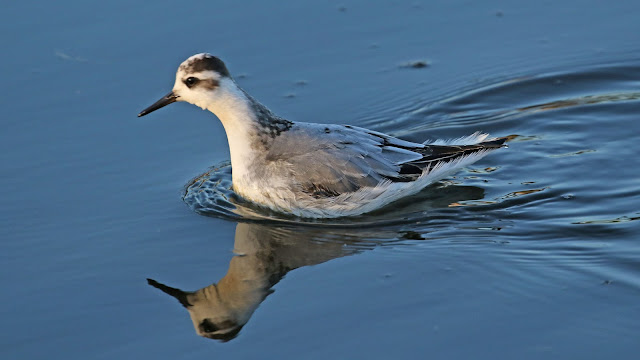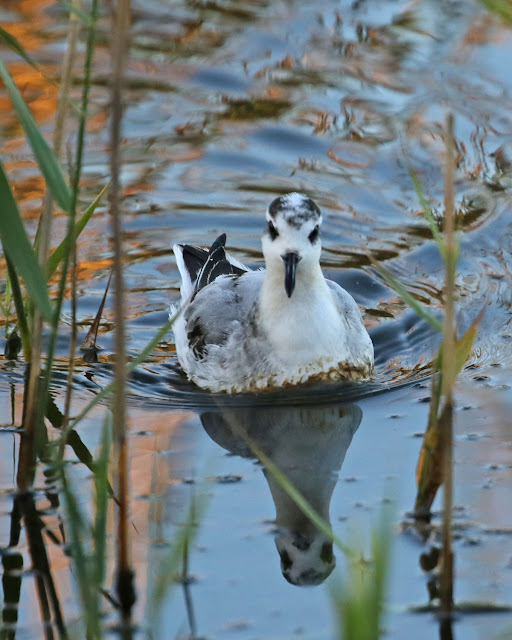Our plans are always fluid through the week as we wait to see what either the weather would deliver or what birds could be about. On Friday morning news broke of a Wilson's Phalarope on Fishtail Lagoon at Pennington. There was no doubt this would spark a major twitch and with parking a premium at Pennington we had to decide what would be the best time to arrive. We opted for 6:30, just under an hour before sun rise. As it was I arrived at around 6:15 and found the car park almost full. It was though immediately clear the cars belonged to wildfowlers who were definitely not their for the phalarope.
Ian arrived a little after me and we were also joined by Mark Francis. Just after 6:30 we walked across the Old Tip towards Fishtail Lagoon in the gloom, the light breaking away to the east across the Solent. I was concerned the clear night might have encouraged the Wilson's Phalarope to have moved on, it was also the coldest morning of the autumn so far with temperatures just above freezing
On reaching the path that drops down alongside the stream by the lagoon we could make out a pale bird on the water, moving closer we could see it was a Grey Phalarope, one of the two that had been there through the week. A good sign but for once we walked past the Grey Phalarope, and headed to the south western corner of the lagoon, the area where the Wilson's had been reported from last night. Out on the salt marsh gun fire pierced the calm of the dawn and one or two other birders that had now joined us commented on the absurdity of allowing this kind of activity alongside a nature reserve.
As we got closer to the corner it was possible to make out another pale grey bird underneath the hedge on the west side. This gives some idea of the available light
Behind us out on the saltmarsh the wildfowlers were still shooting, every time a shot rang out duck would wheel around our heads, the Wilson's would stop and we would hold our breath, hoping that it wouldn't fly off with the duck. Gradually it moved a little closer coming out into more open water, but we were still watching in the gloom, however you could now see clearly the longer body of the Wilson's and the long needle like bill.
Close up the rising sun beneath the horizon was turning the clouds and some light rain fall a deep red.
Then another couple of gun shots and everything went up, including the Wilson's. Binoculars strained to get track of the Phalarope as it flew off to the east with Teal, it headed out over Butts Lagoon, but thankfully turned around and circled back, relieved binocular users following it all the way. We all let out a sigh of relief as it dropped back into the south west corner of the lagoon, but this time much closer to us.
Whilst the behaviour was "phalarope like" it was distinctly different to that of the Grey and Red-necked Phalaropes I have seen. The body is much more elongated and with its long neck it stretches cross the water to pick up insects or seeds from the surface of the water.
The largest of the phalaropes, breeds in the prairies
of North America in western Canada and the western United
States. It is migratory, and should be wintering in inland salt lakes near
the Andes in Argentina, this first winter bird clearly having
strayed well of course.
When feeding, a Wilson's phalarope will often swim in a
small, rapid circle, forming a small whirlpool. This behaviour is thought to
aid feeding by raising food from the bottom of shallow water. The bird will
reach into the outskirts of the whirlpool with its bill, plucking small insects
from the surface.
In comparison the Grey Phalarope will peck at the water surface close to it, but also spinning to disturb the insects.
It was extremely busy feeding and appeared to have no concerns at the number of people that were now turning up to see the bird. Goodness knows where they were parking!
The breeding female is predominantly grey and brown above,
with white underparts, a reddish neck and reddish flank patches. The breeding
male is a duller version of the female, with a brown back, and the reddish
patches reduced or absent.
Young birds as this one is, are grey and brown above, with
whitish underparts and a dark patch through the eye. In winter, the plumage is
essentially grey above and white below, but the dark eye patch is always
present.
From its position out in the open it turned and disappeared into the rushes. We stood and waited for it to return. A Robin sang from a bramble close by above the chatter of the birders that were now present, the sun had finally emerged above the horizon. Overhead Swallows and a single Sand Martin passed through.
We were hearing stories of the confiding nature of the Grey Phalaropes in the south east corner of the lagoon and with the Wilson's currently not showing we decided to go and pay them a visit.
This phalarope is quite dumpy in comparison to its larger
cousin and has a much thicker bill. Non breeding
plumage is smooth grey above and white below with a black eye-patch. Juveniles
are stained with buffy tones.
Both birds were very busy swimming up and down like clockwork bath toy ducks and constantly pecking at the surface of the water, even plunging head first into it. A completely different feeding technique to that seen in the Wilson's earlier.
The pool is alongside the main path to the sea wall and there was a constant traffic of people and dogs, but despite our concerns these little birds showed no fear of either human or dog, coming very close, so close the long lens was not necessary.
After the brief break it was back to the Phalaropes buzzing around the pool like an energiser bunny.
Back in the south west corner the Wilson's Phalarope was hiding in the rushes. Just beyond it's patch the female Pintail was sleeping in the morning sunshine.
The number of birders was building once again and while the phalarope continued to hide distantly in the rushes we decided to walk to Keyhaven and around the Highway.
There was very little along the highway, in fact we were more occupied with directing panicking birders who had taken a wrong turn from the car park
After a cup of tea and something to eat, we headed back to Fishtail, and despite what we had discussed we did stop once again for the Grey Phalarope.
A different feeding technique, plunging into the water, up ending like a duck and giving the opportunity of seeing the lobed feet.
Here at "eye level" showing the rubber bath duck look and also a buff wash on the neck that could indicate a first winter bird.
We finally pulled ourselves away from the Grey Phalarope and headed back to the Wilson's, hoping that it would show better than earlier.
Just past the Jetty we disturbed a wagtail, as it flew it called and then settled on the sea wall, a late Yellow Wagtail.
Past the Jetty a lone Brent Goose stood just off the spit, the only one we saw all day, I had expected more.
We were looking for Spotted Redshank on Oxey Marsh, but first came across a very confiding Greenshank that was focused on preening
A little further along we came across two Spotted Redshank, but as we got closer they flew off back to where we had come from. We decided to go back after them and found them feeding at the back of the lagoon where we had been watching the Greenshank.
A search of Pennington Marsh did not find the reported Ruff so it was back to the car for lunch and then on to the New Forest and Leaden Hall. We were hoping for Ring Ouzel on the plateau there. Our first plan of walking from The Telegraph car park was thwarted due to the number of cars so we headed on the Black Gutter Bottom, parking the cars just off the road and walking down the valley to cross the stream. I couldn't resist the lone tree on the hill, this time in colourful bracken.
Birds are always a premium here but we managed a few Meadow Pipits and Stonechat. On the plateau we could find Blackbirds in the berry rich hawthorn trees but there was no sign of the hoped for Ring Ouzel. In fact the only bird we did see was a single Kestrel.
We walked across the plateau towards Ashley Hole. There were no birds, but there was a large group of Fallow Deer with several stags with good sets of the palmate antlers. As we watched the birds a call above alerted us to two Peregrine above us.
After that we decided we had had enough and headed back to the car. A great day with some amazing photographs. One of those special days that will always be remembered.








































































































































No comments:
Post a Comment